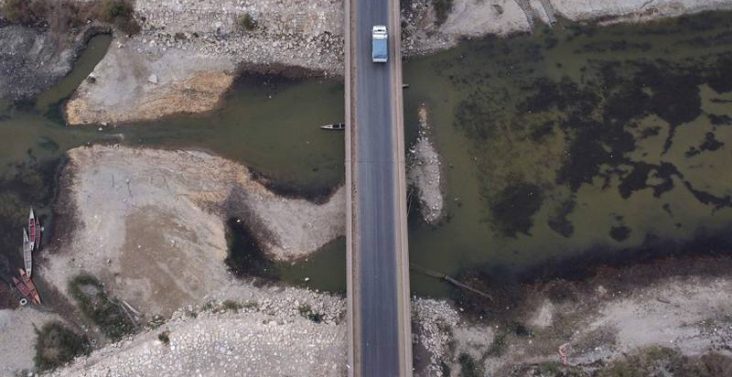In Luzerne County, in northeast Pennsylvania, the Nanticoke Creek is dry most of the time because unless there’s a major storm, any water that flows into it disappears into underground voids created by coal mines that operated there for decades until the 1960s.
The creek has long been a target for restoration by Earth Conservancy, a local nonprofit that works to repair the harms caused by the area’s past reliance on coal mining. Now, thanks to more federal money for mine reclamation from the Bipartisan Infrastructure Law, the group can afford to line a three-mile section of the creek with an impervious layer of clay so that its water will flow again rather than disappearing into the old mine.
More of the infrastructure money, $244 million for Pennsylvania alone, was announced on April 3 by the Biden administration, boosting existing efforts by the state to remediate the harms left behind by mining such as subsidence, water pollution and the destruction of natural waterways.
Earth Conservancy was already promised $17.5 million of federal infrastructure funds to restore the creek, a sum that it expects will enable it to do the whole job in three to five years, starting this summer, much quicker than would have been possible under earlier funding restrictions.
“Because of this injection of funding from the infrastructure bill, this grant is the largest we have ever received for any type of reclamation project. It’s fully funded now. We’ll be able to complete this project in a much shorter time frame,” said Terry Ostrowski, chief executive of the nonprofit. “The major benefit that we’re seeing from the funding from the infrastructure law is that the grants are larger and we’re able to handle larger projects in a shorter period of time.”
In addition to lining the creek, the money will also be used to remove a stream blockage that was left behind by the mine company when it declared bankruptcy in the 1990s.
An earlier Earth Conservancy restoration of another creek that did not win federal infrastructure money took six years to complete, even though the damaged section was much smaller and required the “stitching together” of multiple funding sources, Ostrowski said.
Pennsylvania’s share of the new money is the largest state allocation in 2023 fiscal year funding under the federal Abandoned Mine Land program.
“Legacy pollution continues to impact far too many communities across the nation,” said Interior Secretary Deb Haaland in a statement. “Reclaiming and restoring these sites will create jobs, revitalize economic activity, and advance outdoor recreation across the country.”
The infrastructure law includes $11.3 billion in abandoned mine land (AML) funding over 15 years, a sum that’s expected to address “nearly all” of the abandoned mines that are currently inventoried, according to the Office of Surface Mining Reclamation and Enforcement, a unit of the Department of the Interior.
The new federal money follows an earlier $244 million for Pennsylvania in fiscal year 2022 to close dangerous mine shafts, reclaim unstable slopes, improve water quality by treating acid mine drainage, and restore water supplies damaged by mining. Additional reclamation grants totaling some $295 million have been awarded to 16 other states.
According to research by Millersville University in Pennsylvania, there are 11,249 abandoned mines in the state, of which 9,977 have environmental or health and safety issues.
The infrastructure money will help Pennsylvania’s own longstanding efforts to clean up a long extractive legacy.
In June 2022, a contractor finished reclaiming a dangerous pile of coal waste that had accumulated at an abandoned mine site in Washington County, in southwest Pennsylvania, where riders of dirt bikes and all-terrain vehicles had worsened erosion over years, causing the refuse to flow into residents’ yards and clog drains.
The pile at Black Dog Hollow, rising as high as 90 feet, had been threatening public health and safety since the 45-acre site was abandoned in 1958, but was finally removed and revegetated in a four-year operation costing just over $4 million, according to the Office of Active and Abandoned Mine Operations, a division of the state’s Department of Environmental Protection.
This story is funded by readers like you.
Our nonprofit newsroom provides award-winning climate coverage free of charge and advertising. We rely on donations from readers like you to keep going. Please donate now to support our work.
Black Dog Hollow was one of thousands of sites that have been reclaimed by the heavily mined state in recent decades to meet standards set by the federal Surface Mining Control and Reclamation Act of 1977.
Reclamation of abandoned mine lands also supports economic development by investing in projects that close dangerous mine shafts, reclaim unstable slopes, improve water quality by treating acid mine drainage, and restore water supplies damaged by mining, the federal agency said.
In October 2022, workers completed a new drainage system at a site in Pittsburgh where drainage from an abandoned mine saturated a landmass that could have had a “catastrophic” effect on a nearby home and its garage, according to Pennsylvania records.
The new system diverted water away from the structures and into a sewer. “The reclamation prevented a dangerous slide from occurring and eliminated the public health and safety hazard,” the state agency said.








